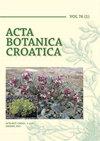Comparative transcriptome analysis of high-growth and wild-type strains of Pyropia yezoensis
IF 0.7
4区 生物学
Q3 PLANT SCIENCES
引用次数: 7
Abstract
Pyropia yezoensis (Ueda) M.S.Hwang et H.G.Choi is a popular edible macro-alga that is found mostly in intertidal zones. It is one of the most economically important seaweed species and has been cultivated extensively in the cold waters of East Asia. Various reports have been published on the isolation and characterization of improved strains of Pyropia. However, there are few studies focusing on the molecular basis underlying these mutant strains. In this study, we performed a comparative analysis of whole transcriptomes of wild-type (PyWT) and high-growth (Py500G) strains of P. yezoensis using next generation RNA sequencing (RNA-seq). After sequencing, a total of 167,110,896 paired-end reads with a length of 151 nucleotides, were obtained. De novo transcriptome assembly and redundancy removal generated 19,441 transcripts. The assembly was annotated in NCBI nr, Swiss-Prot, Pfam, KEGG, GO and KOG databases. To unravel the differences in Py500G and PyWT, we mapped Py500G and PyWT reads to the assembly and calculated the expression levels. In total, there were 454 transcripts that were differentially expressed. Among the differentially expressed transcripts, candidate genes were identified with well-known growth and development functions. This study not only identifies candidate genes responsible for the high-growth phenotype of Py500G, but it also provides more comprehensive genomic data for future research on P. yezoensis.野鱼Pyropia高生长株与野生株的比较转录组分析
yezoensis (Ueda) M.S.Hwang et H.G.Choi是一种流行的食用大藻类,主要分布在潮间带。它是经济上最重要的海藻品种之一,在东亚的冷水中被广泛种植。关于焦皮菌改良菌株的分离和鉴定已经发表了许多报告。然而,很少有研究集中在这些突变株的分子基础上。在这项研究中,我们使用下一代RNA测序(RNA-seq)对野生型(PyWT)和高生长(Py500G)菌株的全转录组进行了比较分析。测序后,共获得167,110,896对末端reads,长度为151个核苷酸。从头转录组组装和冗余去除产生19,441个转录本。该装配在NCBI nr、Swiss-Prot、Pfam、KEGG、GO和KOG数据库中进行了注释。为了揭示Py500G和PyWT的差异,我们将Py500G和PyWT的读取映射到程序集并计算表达水平。总共有454个转录本存在差异表达。在差异表达的转录本中,候选基因被鉴定出具有众所周知的生长和发育功能。本研究不仅确定了Py500G高生长表型的候选基因,而且为今后对叶斑杉的研究提供了更全面的基因组数据。
本文章由计算机程序翻译,如有差异,请以英文原文为准。
求助全文
约1分钟内获得全文
求助全文
来源期刊

Acta Botanica Croatica
PLANT SCIENCES-
CiteScore
2.50
自引率
0.00%
发文量
34
审稿时长
>12 weeks
期刊介绍:
The interest of the journal is field (terrestrial and aquatic) and experimental botany (including microorganisms, plant viruses, bacteria, unicellular algae), from subcellular level to ecosystems. The attention of the Journal is aimed to the research of karstic areas of the southern Europe, karstic waters and the Adriatic Sea (Mediterranean).
 求助内容:
求助内容: 应助结果提醒方式:
应助结果提醒方式:


